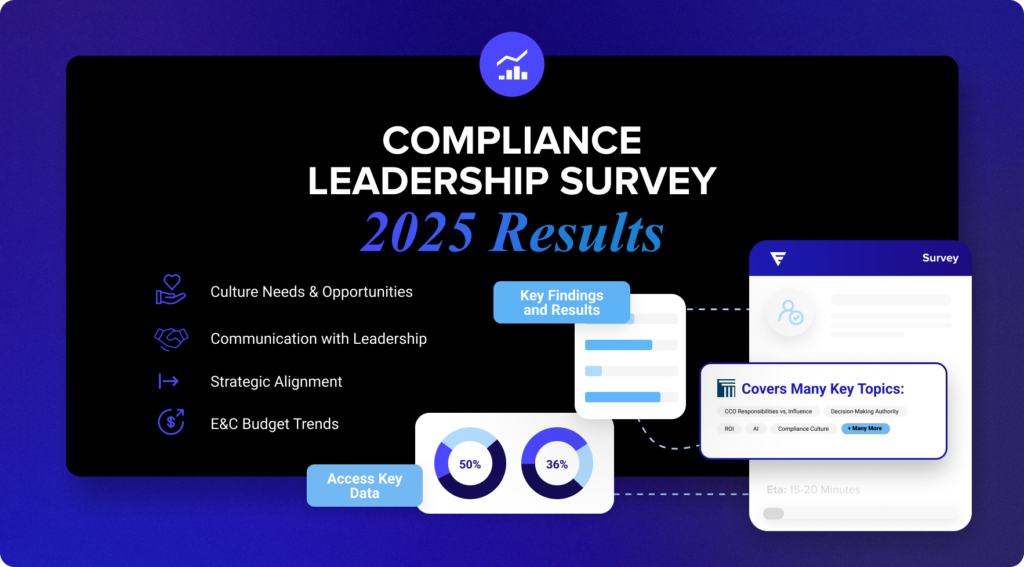2025 Compliance Leadership Redefined Survey Key Takeaways


Access Full Data
Download ReportThe compliance landscape has evolved into an increasingly complex and dynamic environment that requires organizations to fundamentally rethink their traditional approaches. As regulations multiply and business risks evolve, compliance teams must develop more sophisticated and adaptable strategies. Modern compliance challenges extend far beyond simple regulatory adherence. Teams must now navigate emerging technologies, changing stakeholder expectations, and complex global requirements while maintaining ethical business practices and strong organizational cultures.
The joint survey between FTI Consulting and Ethico represents a comprehensive effort to understand current challenges and provide a strategic roadmap for compliance professionals. By analyzing trends and best practices, it aims to help organizations transform their compliance functions from cost centers into strategic assets.
Compliance Landscape Overview
- The compliance field appears to be caught in a period of stagnation, with minimal meaningful progress over the past two years. This lack of advancement suggests that current approaches to compliance management may be insufficient for addressing modern challenges and risks.
- While certain metrics show incremental improvements, the fundamental challenges facing compliance departments remain largely unaddressed. This pattern indicates a need to move beyond surface-level solutions and tackle core structural issues within compliance programs.
- The apparent lack of progress presents a critical opportunity for organizations to fundamentally reimagine their approach to compliance. Rather than viewing this as a failure, organizations can use these findings as a catalyst for transformative change in how they structure and execute their compliance programs.
- The beginning of 2025 marks a pivotal moment for organizations to revolutionize their compliance strategies. With increasing regulatory scrutiny and evolving business risks, the time is right for organizations to implement more innovative and effective approaches to compliance management.
Compliance, Culture, and KPIs
- Organizations have reached a critical juncture in recognizing culture’s fundamental role in compliance effectiveness. While awareness has increased significantly, this understanding hasn’t translated into meaningful cultural transformation. Many organizations struggle with the complex challenge of moving from theoretical appreciation to practical implementation of cultural change.
- The integration of compliance into organizational culture remains a significant challenge. Despite increased efforts and resources devoted to compliance programs, many organizations fail to embed compliance thinking into their day-to-day operations and decision-making processes. This disconnect between intention and execution creates vulnerabilities in compliance programs.
- The failure to integrate compliance into broader business strategy represents a fundamental weakness in many organizations’ approaches. When compliance is treated as a separate function rather than an integral part of business operations, it becomes more difficult to build and maintain a strong compliance culture. This separation often leads to compliance being viewed as an obstacle rather than an enabler of business success.
- The disconnect between compliance and key performance indicators, and the lack of influence in strategic decisions, has persisted. To overcome this gap, it’s critical that compliance professionals re-position themselves as strategic enablers and find new ways to articulate their value to leaders.
Compliance & Business Disconnect
- A significant and troubling divide continues to exist between compliance professionals and business leaders, creating potential risks and missed opportunities. This disconnect manifests in multiple ways, from misaligned priorities to communication challenges, and fundamentally undermines the effectiveness of compliance programs. Until this gap is bridged, organizations will struggle to achieve their compliance objectives.
- Leadership’s understanding of compliance roles and risks often falls short of what’s needed for effective risk management. This knowledge gap leads to inadequate support for compliance initiatives and can result in underestimation of critical risks. The challenge is compounded by insufficient time allocated for meaningful compliance discussions at the board level, preventing thorough examination of important issues.
- The prioritization of operational efficiency over compliance effectiveness represents a short-sighted approach that could expose organizations to significant risks. This mindset often leads to under-resourcing of compliance functions and can create an environment where compliance concerns are minimized or overlooked in favor of immediate business goals.
- Reports confirm that the prominence of compliance topics on board agendas has increased. Compliance professionals must find ways to capitalize on this increased interest by finding novel ways to engage their audience and express the importance of compliance. Success requires developing concise, compelling approaches that capture Board attention and underscore compliance’s strategic value.
Compliance’s Strategic Influence
- The evolving role of Chief Compliance Officers reflects a concerning trend where increased operational authority is offset by diminished strategic influence. While CCOs have gained more day-to-day decision-making power, their exclusion from strategic planning and key business decisions suggests a limitation in how organizations view the compliance function. This dynamic prevents compliance from fully contributing to organizational success and risk management.
- The decreased influence of compliance officers in strategic business direction represents a significant missed opportunity for organizations. With their unique perspective on risk management and regulatory requirements, compliance officers could provide valuable input into strategic decisions. Their reduced involvement in high-level planning may leave organizations vulnerable to unforeseen risks and regulatory challenges.
- The limited input of compliance officers in crucial areas such as AI, data privacy, and ESG policies is particularly troubling given the growing importance of these domains. As organizations face increasing scrutiny and regulation in these areas, the lack of compliance perspective in policy development could lead to significant vulnerabilities. This gap in expertise at the strategic level may result in policies that fail to adequately address regulatory requirements or manage associated risks.
- Compliance processionals continue to be excluded from key decisions in major sectors. Rather than viewing limited strategic input as a barrier, compliance officers can use their broadening operational role to forge partnerships that naturally lead to strategic influence.
Demonstrating ROI & Regulatory Pressure
- The decreasing emphasis on compliance ROI measurement signals an important shift in how organizations perceive compliance value. Rather than viewing compliance purely through a cost-benefit lens, organizations are beginning to recognize it as an essential component of risk management and business strategy. This evolution in perspective could lead to more mature and effective compliance programs.
- Resource constraints continue to pose a significant challenge for compliance programs, affecting their ability to implement comprehensive risk management strategies. The lack of adequate personnel, tools, and technology not only hampers current operations but also limits organizations’ ability to prepare for and respond to emerging risks. This resource gap becomes particularly critical as regulatory requirements and business complexities increase.
- The recognition of compliance as a risk management tool rather than a cost center represents a positive evolution in organizational thinking. This shift suggests a more sophisticated understanding of compliance’s role in protecting and enabling business success. However, this conceptual change hasn’t always translated into proper resource allocation or strategic positioning.
- Regulatory pressures and cultural challenges create a complex environment for compliance teams to navigate. The combination of increasing regulatory requirements, rapid technological change, and entrenched cultural resistance to compliance initiatives creates a particularly challenging operational environment. Success requires a delicate balance of technical expertise, change management skills, and strategic thinking.
Compliance Budget Decisions
- Reports show noticeable trend towards increased investment in compliance, however, they have little decision-making authority over that increased budget.
- The fragmented control of compliance budgets across multiple executive positions creates significant challenges for program coherence and effectiveness. When budget decisions are distributed among CEOs, boards, general counsel, and other executives, it becomes increasingly difficult to maintain a consistent and strategic approach to compliance investment.
- The limited influence of compliance professionals over their own budgets represents a fundamental challenge to program success. Without meaningful input into resource allocation decisions, compliance teams struggle to align available resources with identified risks and program needs. This disconnect between expertise and budgetary control can lead to misaligned investments and gaps in risk coverage. The inability to direct resources where they’re most needed hampers the effectiveness of compliance programs and limits their ability to adapt to emerging risks.
- The upward trajectory is less robust than in previous years, but still indicates the increasing respect towards compliance as a business function. Compliance professionals should continue to find new ways to articulate their value.
The Effects of the DOJ’s Whistleblower Program
- The minimal impact of the DOJ’s whistleblower program on organizational compliance culture reveals a deeper challenge in how organizations approach compliance initiatives. Despite the program’s significant potential consequences, organizations have largely failed to use it as a catalyst for meaningful cultural change. This suggests a reactive rather than proactive approach to compliance management, where external pressures alone are insufficient to drive substantial internal transformation.
- The gap between policy implementation and cultural transformation in speak-up programs represents a critical vulnerability in many organizations’ compliance efforts. Simply having policies and procedures in place doesn’t ensure their effectiveness if the organizational culture doesn’t support their use. Organizations need to focus on building cultures where employees feel genuinely safe and encouraged to raise concerns.
- The focus on enhancing reporting mechanisms without addressing deeper cultural issues reflects a common but problematic approach to compliance. True program effectiveness requires a balanced approach that combines robust processes and systems with cultural elements that support their use. Organizations must move beyond checkbox compliance to create environments where ethical behavior and speaking up are truly valued and encouraged.
- The greatest opportunity lies in compliance leaders’ ability to create a holistic approach to Speak Up culture, not only taking into account the potential financial consequences, but the larger cultural consequences of a poor culture.
Compliance Incident Preparedness
- The widespread lack of preparedness for significant compliance incidents represents a critical vulnerability in organizational risk management. This unpreparedness goes beyond simply lacking response procedures – it reflects deeper issues in how organizations view and prioritize compliance risk. The inability to effectively handle compliance incidents can lead to cascading negative effects, from regulatory consequences to long-term reputational damage and decreased employee trust. Organizations must recognize that incident preparedness is not just about having plans in place, but about building resilient compliance systems that can adapt to and overcome challenges.
- The insufficient collaboration between compliance functions and other key business units reveals a siloed approach to risk management that undermines program effectiveness. When compliance teams operate in isolation from communications, business continuity, and other critical functions, organizations lose the ability to respond cohesively to challenges. This lack of integration not only hampers incident response but also prevents the development of proactive risk management strategies that could prevent incidents from occurring in the first place.
- The low satisfaction among compliance professionals with their programs’ effectiveness signals a critical need for fundamental changes in how organizations approach compliance. When the very professionals responsible for managing compliance programs lack confidence in their effectiveness, it suggests systemic issues that require strategic intervention.
- Compliance leaders must leverage their expertise to assist other leaders within their organization. By doing so, they may create new opportunities to collaborate with other departments and create a more robust response mechanism to potential compliance incidents.
Conclusion
The 2025 Compliance Leadership Redefined survey reveals a compliance function at a critical crossroads. While organizations increasingly recognize the importance of strong compliance programs, many struggle to translate this awareness into effective action. The persistent gaps between understanding and implementation, between compliance teams and business leadership, and between available resources and growing demands all point to a need for fundamental transformation in how organizations approach compliance.
The findings suggest that 2025 represents a crucial moment for organizations to reimagine their approach to compliance. Those that successfully transform their compliance functions from regulatory checkboxes into strategic assets will be better positioned to navigate an increasingly complex risk landscape. This transformation requires bold leadership, sustained investment, and a commitment to building cultures where ethical behavior and effective risk management are truly valued as drivers of business success.




































